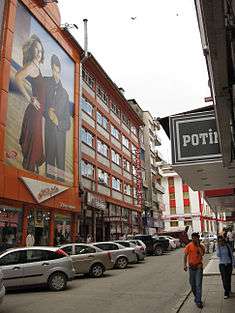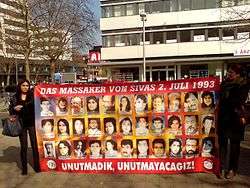Sivas massacre
The Sivas massacre (Turkish: Sivas Katliamı, Madımak Katliamı) refers to the events of July 2, 1993 at the Hotel Madimak (Otel Madımak), which resulted in the killing of 37 people, mostly Alevi intellectuals.[1] The victims, who had gathered in the hotel for the Pir Sultan Abdal festival in Sivas, Turkey, were killed when a mob set fire to the hotel where the Alevi group had assembled.[2][3]
| Sivas Massacre | |
|---|---|
 Otel Madımak in Sivas, site of the Alevi massacre on 2 July 1993 | |
| Location | Sivas, Turkey |
| Date | 2 July 1993 |
| Target | Alevis, Socialists |
Attack type | Massacre, Arson |
| Deaths | 37 killed (including 2 perpetrators) |
| Injured | 51+ |
| Perpetrator | Islamic fundamentalist mob |
The incident
Attending the conference was a left-wing Turkish intellectual Aziz Nesin, who was greatly hated amongst Muslims in Turkey because he attempted to publish Salman Rushdie's controversial novel, The Satanic Verses, in Turkey.[4] Thousands of Sunni locals in Sivas, after attending Friday prayers in a nearby mosque, marched to the hotel in which the conference was taking place and set the building on fire. The Turkish government sees this incident as being aimed at Aziz Nesin only, Alevi commentators agree that the target were the Alevis since the mob also destroyed a statue depicting Pir Sultan Abdal erected the day before the arson attack.[3] Many victims were well known Alevi intellectuals and musicians. The poets Hasret Gültekin and Metin Altıok were also killed in this fire.[5]
Arson attack
The attack took place not long after traditional Friday prayers, when the mob broke through police barricades to surround the Hotel Madımak, where artists, writers and musicians had gathered to celebrate the life of 16th-century Alevi poet Pir Sultan Abdal. The hotel was set alight, and the fire claimed 37 lives, including those musicians and poets attending the festival.[1] Aziz Nesin managed to escape the fire over a ladder. After the firemen recognized who he was, they started to attack him, but he ran away.[6]
Indictments, trial and sentences
The event was seen as a major assault on free speech and human rights in Turkey, and significantly deepened the rift between religious and secular segments of the society. A day after the incident, 35 people were arrested. Then the number of detainees increased to 190. A total of 124 out of the 190 defendants were charged with "attempting to establish a religious state by changing the constitutional order" and were indicted on charges. The first hearing of the case, publicly known as the Sivas Massacre Trial, Ankara State Security Court No. 1, was held on 21 October 1993. On 26 December 1994 a verdict was reached in the case of the 124 defendants: 15 years in prison for 22 suspects, 10 years in prison for 3 defendants, 3 years and 9 months for 54 suspects, 2 years and 4 months for 6 suspects, and the acquittal of 37 of the defendants. Another 14 suspects were sentenced to 15 years in prison. The remaining 33 defendants were charged with 35 counts of murder. After lengthy court proceedings, the State Security Court sentenced the 33 defendants to death on 28 November 1997 for their roles in the massacre; 31 of these sentences were upheld in a 2001 appeal.[7] When Turkey overturned the death penalty just over a year later in 2002, the sentences were commuted. Each defendant received 35 life sentences, one for each murder victim and additional time for other crimes. These 31 convicts are currently the only ones still serving time for the crimes; the other defendants were paroled early or released after completing their sentences. In January 2020, Ahmet Turan Kılıc, who at first was sentenced to death for his involvement in the Sivas massacre, was granted a commutation of his sentence by Recep Tayyip Erdogan. As a result his sentence was removed.[8]

The aftermath
The response from the security forces at the time and afterwards was weak. The assault took place over eight hours without any intervention by the police, military or fire department. Alevis and most intellectuals in Turkey argue that the incident was triggered by the local government as flyers and leaflets were published and given out for days before the incident. The Turkish government refers to the Sivas Madımak Hotel incident as an attack on intellectuals but refuses to see it as an incident directed towards Alevis. The events surrounding the massacre were captured by TV cameras and broadcast all over the world. Every year, during the anniversary of the massacre, various Alevi organizations call for the arrest of those responsible.
Two of the suspects, including Cafer Erçakmak died while on trial. In March 2012, the Sivas massacre case against the remaining five defendants was dropped, owing to the statute of limitations. However, this case is still being appealed.[9]
Commemoration
Each year on the anniversary of the massacre, demonstrators hold protests and vigils to commemorate the victims of the fire.[10] Many wish to see the hotel, which has since re-opened, declared a memorial and turned into a museum.[10] In 2008 a government minister indicated that it would be turned into an Alevi cultural center,[11] but this has yet to occur. In June 2010, the Minister of Work and Social Security announced that the money for buying the hotel had been transferred, and that the Ministry would provide additional resources for restoration.[12] Following the court ruling on 23 November 2010, Hotel Madimak has become a public entity for a compensation of 5,601,000 TL to the hotel owners.[13]
See also
References
- Çaylı, Eral. "Architectural Memorialization at Turkey's Witness Sites: The Case of the Madimak Hotel" (PDF). p. 14. Retrieved 31 January 2020.
- HDP. "We Will Not Forget the Sivas Massacre". www.hdp.org.tr. Retrieved 2020-01-31.
- Çaylı, Eral. "Architectural Memorialization at Turkey's Witness Sites: The Case of the Madimak Hotel" (PDF). p. 20. Retrieved 31 January 2020.
- Pace, Eric (1995-07-07). "Aziz Nesin of Turkey Dies at 80; Writer Escaped Militants' Arson". The New York Times. ISSN 0362-4331. Retrieved 2020-01-31.
- Karaca, Ekin. "The Ones Massacred in Madımak 26 Years Ago Commemorated in Sivas". Bianet. Retrieved 31 January 2020.
- Pace, Eric (1995-07-07). "Aziz Nesin of Turkey Dies at 80; Writer Escaped Militants' Arson". The New York Times. ISSN 0362-4331. Retrieved 2020-01-31.
- Frantz, D. "Turkey's Choice: European Union or the Death Penalty" New York Times, 30 May 2001. Accessed 21 January 2008.
- Adal, Hikmet. "From Zeynep Altıok to Erdoğan: There are Hundreds of Ill Prisoners". Bianet. Retrieved 31 January 2020.
- "Sivas massacre case dropped on statute of limitations". Todayszaman.com. 2012-03-13. Archived from the original on 2013-02-18. Retrieved 2012-11-22.
- Çaylı, Eral. "Architectural Memorialization at Turkey's Witness Sites: The Case of the Madimak Hotel" (PDF). p. 18-19. Retrieved 31 January 2020.
- Dinc, Ahmet (2008-12-27). "State to convert Madımak Hotel into cultural center". Today's Zaman. Retrieved 2008-12-27.
- "Turkish gov't buys hotel site of Alevi massacre". Hürriyet Daily News. June 17, 2010. Retrieved June 17, 2010.
- "Madımak Oteli devletin oldu - Sabah - 22 Kasım 2012 - 23 Kasım 2010". Sabah. 2010-11-23. Retrieved 2012-11-22.
External links
| Wikimedia Commons has media related to Sivas massacre. |